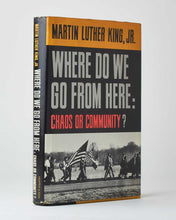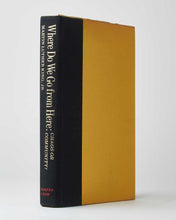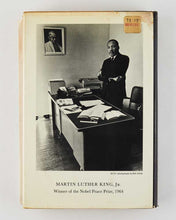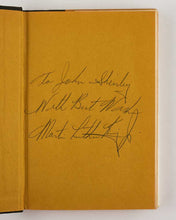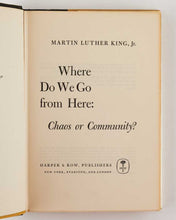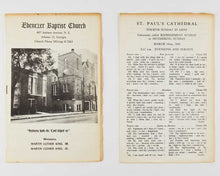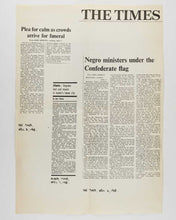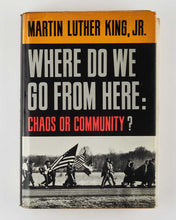
Inscribed by Martin Luther King
KING, Martin Luther, Jr. Where Do We Go from Here: Chaos or Community? New York: Harper & Row. 1967.
8vo. Original black cloth-backed yellow boards, gilt lettering to spine, with illustrated dustwrapper; pp. [viii], 209; dustwrapper slightly dampstained to head of spine, generally very good; presentation inscription “To John Shirley/ With best wishes/ Martin Luther King Jr” to front free endpaper; with loosely inserted: Order of service for Ebenezer Baptist Church, 2 July 1967 (8 pp.); Order of service for St Paul’s Cathedral, Evensong (4 pp., featuring a sermon by King’s wife Coretta), 16 March 1969; A3 sheet of three photocopied stories in The Times and The Sunday Times from 1968 by Shirley regarding King, his legacy and the civil rights movement (see below).
First edition of King’s fourth book, a rare presentation copy inscribed by the author to English journalist John Shirley (1943-2018), offered with orders of service for King’s Ebenezer Baptist Church and St Paul’s Cathedral, together with copies of Shirley’s contemporary articles on King.
King wrote Where Do We Go from Here in complete isolation in a rented house in Jamaica. It is a serious yet hopeful book, making plain the differences between the author’s nonviolent approach to protest and the militarism of the Black Panthers, which he considered self-destructive. King promotes the idea of a unified, equal society underpinned by a form of guaranteed minimum income, recognising that social division is rooted in poverty. This is a radical work by a profoundly visionary thinker that is cited by economists, as well as civil rights activists, to this day.
Provenance: The story behind this remarkable copy was recounted by John Shirley himself in an email to his son, dated 2 June 2017:
“In the summer of 1967, I was a reporter/researcher on This Week, the ITV equivalent of Panorama. Godfrey [Hodgson] and I went to the US to make a programme about the civil rights movement, at a time when there was large-scale rioting going in [sic] on in many large cities in the northern United States – Detroit, Newark, Buffalo, NY, etc. Godfrey worked mainly in the north; I went to the South, where the civil rights movement had begun.
My brief was to get an interview with Martin Luther King. This was difficult because he was very busy, and his public relations people couldn’t really be bothered with a foreign TV crew. So I decided the best way to contact him directly was to go to his church, the Ebenezer Baptist Church in Atlanta, where he and his father were the ministers. So I pitched up there one Sunday morning and sat through the service, and heard King and his father preach from the pulpit as a couple, shouting and responding to the audience just like you see in the movies. It was incredible; I’m getting goose pimples even now writing this. I was the only white person there, but people were very polite and friendly; this was a church service, remember (not unlike one at the Grace Baptist Church in Warboys, where we went the other week).
Anyway, after the service, everyone went into the vestry for tea and cake and a Sunday morning catch-up, and I introduced myself to King and his father. He was totally friendly, quite impressed that I’d got there and invited me back for supper that evening at his home with Coretta and his family. We didn’t have a film crew in Atlanta at the time, so he agreed to do the interview in Cleveland, Ohio, a few days later. And that’s what happened.
The following spring, at Easter 1968, in my university vacation, the TV company wanted me to go back to the South to research another documentary about the white backlash against the civil rights movement. So I went to Montgomery, Alabama, partly to talk to the church people there who were involved with King in the bus boycott that started the civil rights movement. That’s when I met Ed Nixon and Rosa Parkes [sic]. I was there when King was assassinated (a long way away in Memphis), which is how I got to cover the assassination story”.
The Ebenezer Baptist Church order of service is from that meeting, while the book, which had only just been published, was likely presented to Shirley on the same day. The Times cuttings represent his journalistic output during early 1968 in the aftermath of King’s assassination. He was instrumental in spreading the legacy of Martin Luther King to British shores.
Shirley was a highly respected journalist who worked on television, notably Granada’s World In Action and LWT’s The London Programme, and in print, at The Times, The Observer and The Guardian. Apart from his work with the civil rights movement, he won awards for his coverage of the Brixton riots and the Falklands War, and was taken so seriously as an authority on the Northern Irish Troubles that he gave evidence at the internment inquiry of 1971. This gift from Martin Luther King Jr is not only a testament to that great man’s influence and generosity of spirit, but also to the importance of good journalism and John Shirley’s dogged pursuit of his story.
#2121448








